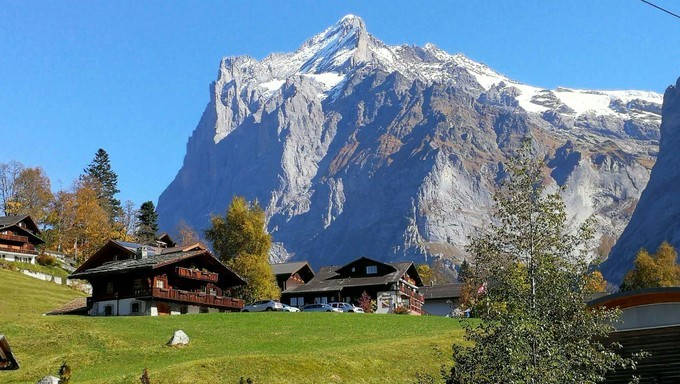Today, we are going to climb Jungfrau.
Interlaken is a Swiss town about a two-hour drive from Mulhouse in French.
As soon as we enter Switzerland, a beautiful plateau mountain scenery opens out before us.
Interlaken takes its name from its geographical position between the lakes (in Latin inter lacus). The Aare flows through the town from one to the other lake, whilst the Lutschine flows from the southern mountains into Lake Brienz however not running through the municipality of Interlaken. The town located at the foot of Jungfrau is very beautiful.
The Hoheweg is Interlaken’s main street which runs between Interlaken West and Interlaken Ost Railway Stations. On this street you will find many souvenir shops. Have a look at Hoehe Matte Park, the 150-year old Victoria Jungfrau Grand Hotel, and don’t miss the beautiful view of the famous snow-covered Jungfrau from Hoehe Matte Park.
Today, the weather is wonderful, paragliders land on the Great Lawn of Hoehe Matte Park from time to time. I really wanna play this paraglider, unfortunately, time does not permit.
Casino Kursaal is even more for cultural activity purposes. It was built in 1859 and rebuilt in 1968. A variety of public activities, cultural entertainment activities such as elegant dance, annual music week, folk song and dance performances, local exhibitions, trade fairs, etc are held here.
We go by train from Interlaken to Lauterbrunen and start our journey.
The left red train is for Lucerne, we are waiting for a train on the right railway platform.
When I see the ice mountain, I may be a bit excited.
The total one-way traveling time from Interlaken Ost to Jungfraujoch-Top of Europe station is just over two hours.
The Jungfrau at 4,158 metres (13,642 ft) is one of the main summits of the Bernese Alps, together with the Eiger and Monch, the Jungfrau forms a massive wall overlooking the Bernese Oberland and the Swiss Plateau, one of the most distinctive sights of the Swiss Alps.
From Interlaken Ost (567 m / 1,860 ft), two routings are available to Jungfraujoch-Top of Europe station – either travel via Lauterbrunnen (796 m / 2,612 ft) or via Grindelwald (1,034 m / 3,094 ft). The time needed and the price of tickets are the same for both routes and it is possible to travel up via the one route and return via the other.
Railway journeys from Interlaken to the Jungfraujoch start on the Berner Oberland Bahn (BOB) trains from Interlaken Ost station. Enter the correct carriage as the train splits in Zweilutschinen with different wagons traveling to Lauterbrunnen (20 minutes) and Grindelwald (35 minutes).
Lauterbrunnen and Grindelwald are famous as the best spots to watch Jungfrau, the tourists can see Jungfrau in their hotel rooms.
At either Grindelwald or Lauterbrunnen (via Wengen), change to a WAB cogwheel train heading towards Kleine Scheidegg. The train from Grindelwald takes just over half an hour while the trains from Lauterbrunnen need around 45 minutes to reach Kleine Scheidegg.
From Kleine Scheidegg, the Jungfraubahn trains go through the mountain to Jungfraujoch-Top of Europe station. This last section of the route takes 50 minutes – up-bound trains stop twice at special viewing points inside the tunnel to allow passengers to get off for a few minutes of sightseeing.
On the way to Jungfrau, At Lauterbrunnen we transfer to another train.
Lauterbrunnen is a mountain town, the scenery of Lauterbrunnen is very beautiful. This is one of the best four towns to watch Jungfrau. The other three are Grindelwald, Wengen, and Mirren.
If you are independent travel, staying in these small towns is a good choice, especially in Grindelwald and Lauterbrunnen, changing trains is particularly convenient.
From Lauterbrunnen to Kleine Scheidegg, the cogwheel train send the tourists up the mountain.
Several workers are cleaning the fallen leaves near Kleine Scheidegg.
Several workers are providing the maintenance of the railway track and guarantee the security of railway traffic.
Kleine Scheidegg railway station is coming, we have to change here for a train to Jungfrau.
There is a coffee shop sell coffee drinks at the station, we can get some calories here.
While we are waiting for the train, at half-past two in the afternoon, mountain snow is shining in the sun.
From Kleine Scheidegg, the Jungfraubahn trains go through the mountain to Jungfraujoch-Top of Europe station.
Going out of Jungfrau railway station, we take a high-speed elevator to the Sphinx Observation Deck at an altitude of 3,571 meters.
The Observation Deck was built on a vast ice surface and was surrounded by handrails guardrail.
The Observation Deck offers 360 views of Jungfrau, Moench and Eiger within many kilometers, the panorama of snow mountain is very spectacular.
In good weather, I feel Jungfrau in front.
Two or thirty meters below the Observation Deck, there is an ice palace, which is an ice cave caved out of the million-year-old ice layer. Many ice sculptures are crystal clear.
The tour guide sends us a Jungfrau railway centennial passport in the break room of the Observation Deck, Jungfraujoch-Top of Europe station manager imprints the passport with a seal and gives us the passport as a keepsake.
Stamped by Jungfrau railway station, I keep mementos.
We get an up-close view of the beautiful snow and ice world.
The Aletsch Glacier has been listed as World Natural Heritages.
On the return trip, we see the snow mountain of sunrise.
Dorint hotel is a true mountain hotel, from which hotel guests can almost reach out and touch the 2,000m high Niederhorn, or the legendary Eiger North Face.
